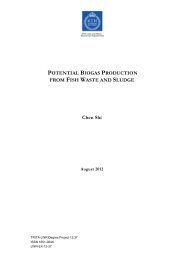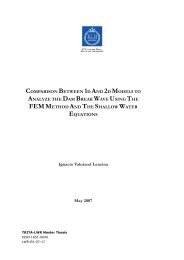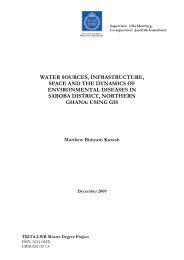radon in groundwater - Mark- och vattenteknik - KTH
radon in groundwater - Mark- och vattenteknik - KTH
radon in groundwater - Mark- och vattenteknik - KTH
- No tags were found...
You also want an ePaper? Increase the reach of your titles
YUMPU automatically turns print PDFs into web optimized ePapers that Google loves.
Radon <strong>in</strong> <strong>groundwater</strong> - Influenc<strong>in</strong>g factors and prediction methodology for a Swedish environmentCONCLUSIONS• Radon concentration <strong>in</strong> <strong>groundwater</strong>was successfully analysed throughmultivariate statistical analyses. Therisk variable method was useful toidentify areas with <strong>in</strong>creased <strong>radon</strong>concentrations <strong>in</strong> the <strong>groundwater</strong>.• Factors of significance for the predictionof <strong>radon</strong> <strong>in</strong> <strong>groundwater</strong> were:type of bedrock, type of soil, altitude,distance to a fracture zone and the distributionof uranium <strong>in</strong> the bedrock.• Visual data m<strong>in</strong><strong>in</strong>g revealed correlationpatterns <strong>in</strong> a prelim<strong>in</strong>ary stage ofdata analysis but were not useful as an<strong>in</strong>dependent method to draw conclusionsregard<strong>in</strong>g <strong>radon</strong> concentrations<strong>in</strong> <strong>groundwater</strong>. The 3D visualisationsof the dataset did not show any newpattern but <strong>in</strong>stead confirmed the correlationsgiven from statistical analyses.• A weak correlation existed between222 Rn and 226 Ra or 238 U <strong>in</strong> the <strong>groundwater</strong>,<strong>in</strong>dicat<strong>in</strong>g that the ma<strong>in</strong> sourceof 222 Rn <strong>in</strong> <strong>groundwater</strong> was not orig<strong>in</strong>at<strong>in</strong>gfrom its parent elements (asions) <strong>in</strong> solution.FUTURE WORKThe present research evaluated differentspatial data for the purpose of develop<strong>in</strong>g a222prediction methodology for Rn <strong>in</strong><strong>groundwater</strong> on a general scale. However,the dynamics of subsurface processes, whichprobably have a strong <strong>in</strong>fluence on theoccurrence and migration of radionuclides( 222 Rn, 226 Ra and 238 U), were not studied. Thegoals for future work would thus <strong>in</strong>clude thefollow<strong>in</strong>g issues:1. Clarification of <strong>groundwater</strong> chemistry<strong>in</strong> connection with high natural radioactivity<strong>in</strong> <strong>groundwater</strong>. Ge<strong>och</strong>emicalmodell<strong>in</strong>g will be carried out<strong>in</strong> order to identify and quantify ge<strong>och</strong>emicalprocesses govern<strong>in</strong>g uraniummobilisation and fixation and to developan understand<strong>in</strong>g of the longtermeffects of oxidation-reduction onact<strong>in</strong>ide (uranium) behaviour. Additionalchemical data are needed forthat purpose and a sampl<strong>in</strong>g programmeconsist<strong>in</strong>g of water sampl<strong>in</strong>gand chemical analyses of <strong>groundwater</strong>needs to be carried out.2. The variation <strong>in</strong> radionuclides <strong>in</strong><strong>groundwater</strong> over time and season willalso be <strong>in</strong>vestigated. For that purpose,about five wells will be sampledmonthly over a period of one year.3. The transport mechanisms of 222 Rnand its parent elements ( 226 Ra and238 U) are highly relevant subsurfaceprocesses that need to be studied. Exist<strong>in</strong>gtransport models for these radionuclideshave previously been developed<strong>in</strong> connection with <strong>in</strong>vestigationsregard<strong>in</strong>g repository sites fornuclear waste. These models are oftenvery detailed and their applications ona general scale have not been tested.The goal is to evaluate these modelsand formulate a simplified processbasedtransport model for <strong>radon</strong> <strong>in</strong><strong>groundwater</strong>.4. In a f<strong>in</strong>al stage, an operative methodfor vulnerability assessment of <strong>radon</strong>content <strong>in</strong> wells based on the outcomeof the modell<strong>in</strong>g and previous generalisedstudies <strong>in</strong> GIS will be formulated.Such a tool will be helpful <strong>in</strong> decisionmak<strong>in</strong>gprocesses concern<strong>in</strong>g plann<strong>in</strong>gof new wells or effective remediationmeasures.19
















